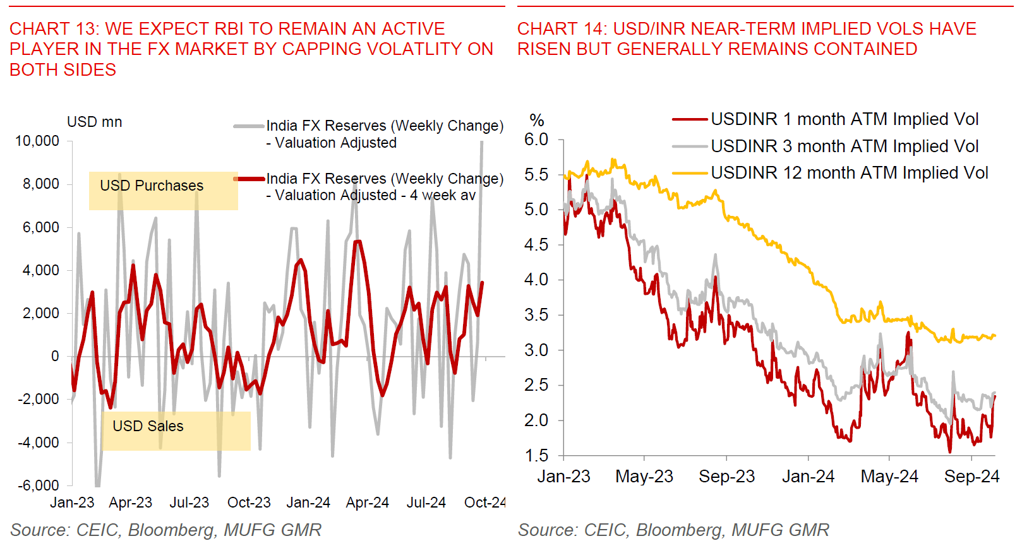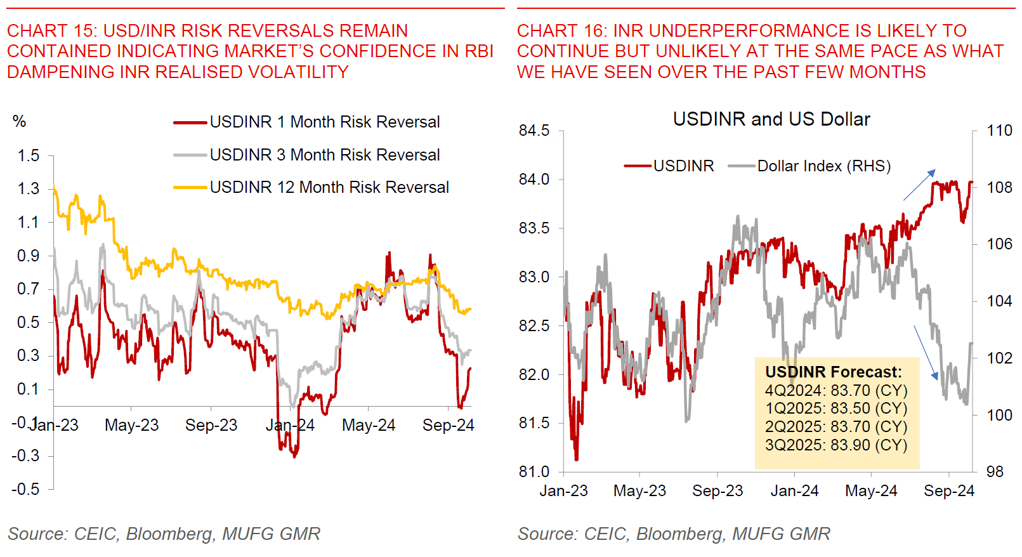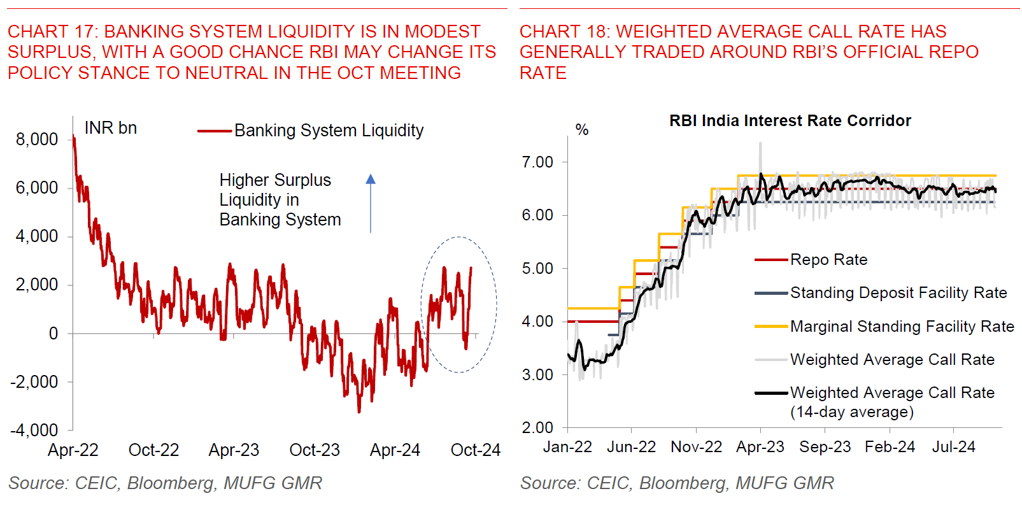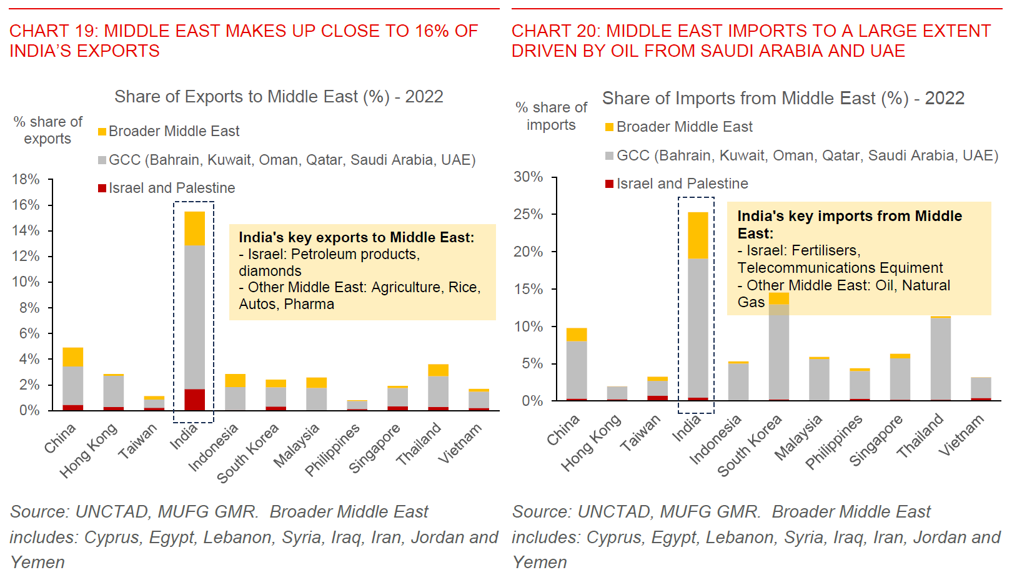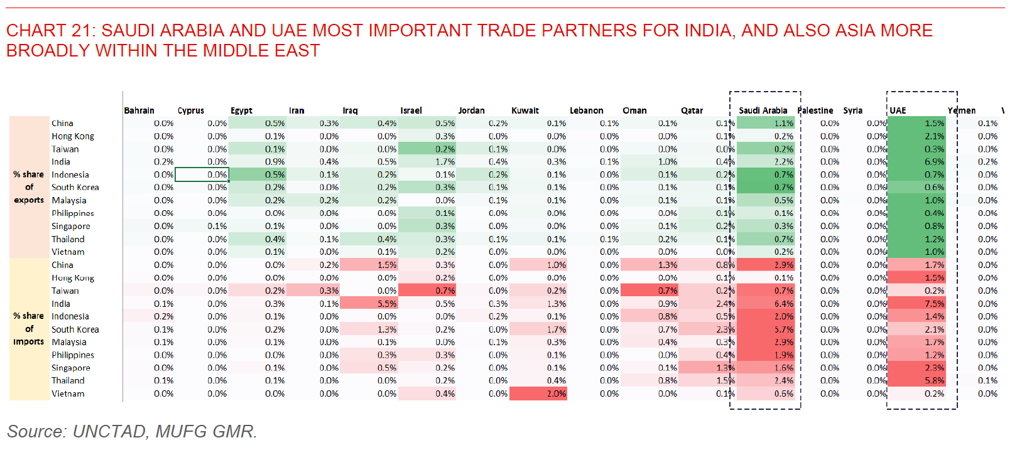We now expect RBI to start its rate cut cycle from December, and bring the repo rate to 6% by 1Q2025 (calendar year). We also see a good chance that the RBI may change its policy stance to neutral in its upcoming meeting on 9 Oct. The key reason for the change is some softening in urban consumption which has likely gone beyond just post-election slowdown effects. We think this, together with signs of a decent outturn in the Southwest Monsoon should be enough to result in a modest and also earlier change in stance by the RBI. Overall, we continue to expect the rate cut cycle to be a shallow one for a total of 50bps (see Asia 4Q2024 - Ride with the tide)
We forecast USD/INR to trade between 83.50 and 84.00, underperforming Asian currencies as the Dollar weakens, with a Harris Presidency + split Congress our base case assumption for the US elections. Geopolitical risks in the Middle East and possible spikes to oil prices are also key left tail risks: We expect RBI to remain an important player and cap any sharp moves in INR both ways. The nuance is that we are effectively assuming a Harris Presidency in our base case, and the impact of a possible Trump Presidency on INR will also depend on the extent and timing of his proposed tariffs. As a general statement, we think INR should be less volatile than the likes of CNY and KRW – but certainly not completely immune – if Trump is to be elected as President and meaningful tariffs were to be imposed. We also have geopolitical risks in the Middle East to contend with. While our base case is for a modest move higher in oil prices to the US$80+/bbl handle, we note India is relatively more exposed in a left-tail risk scenario, both because of possible spikes to oil prices widening the trade deficit, and because India is relatively more exposed to GCC/Middle East end-demand compared with other Asian countries.


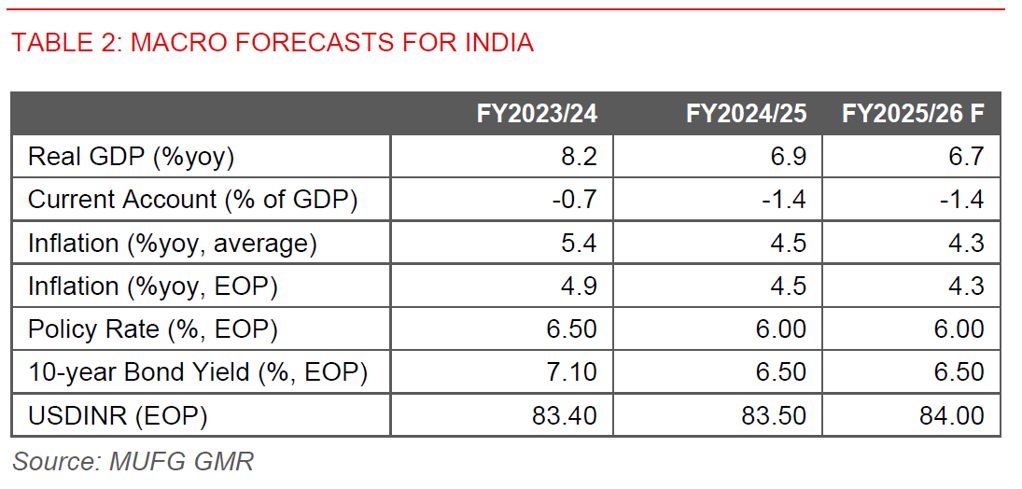
We expect some modest slowdown in growth to around 6.7% in FY2025 from 6.9% in FY2024: While we think headline growth in India should still remain quite robust, the composition is likely to look somewhat different. In particular, there has been a noticeable moderation in urban consumption especially in durables spending such as passenger vehicle sales (see Charts 3 below and Chart 1 above). The preliminary indicators for passenger vehicle sales shows a sharp 19%yoy decline in September. In addition, even though the rural economy looks poised for recovery, there has also been some sequential slowing in areas such as tractor and two-wheeler registrations. On the contrary, investment-related indicators remain quite robust, with capital goods and steel consumption all growing strongly.
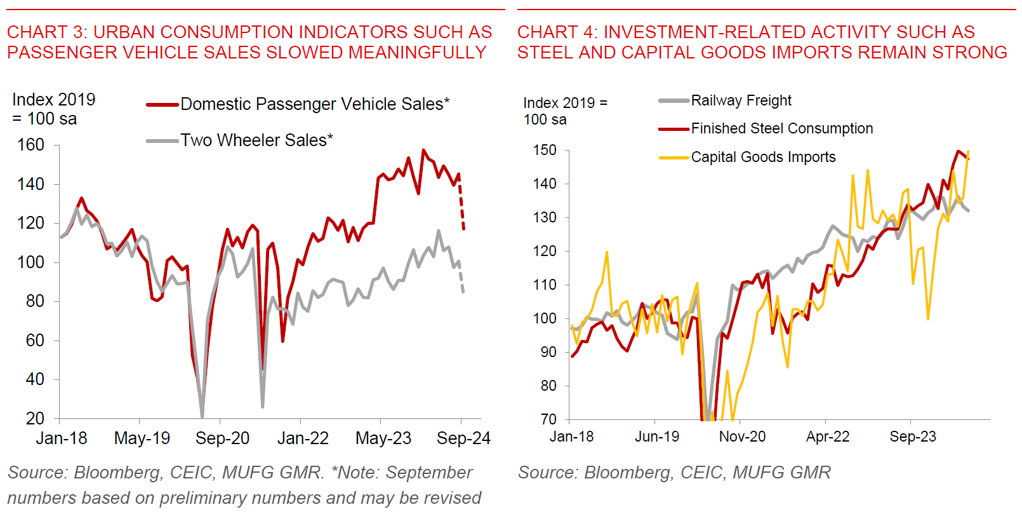
Macroprudential tightening by RBI likely having a larger than anticipated effect, while decent Southwest Monsoon and Kharif sowing should support rural recovery: Beyond the post Lok Sabha election-related slowdown, we think what’s driving the slowdown in urban consumption could be due to the cumulative impact of macroprudential measures that RBI has been implementing since last year. The good news is that the Southwest Monsoon has been quite decent, at 8% above normal while the distribution of rainfall across key agriculture producing states outside of Bihar and Punjab have been around or above normal. Overall, we expect growth to slow slightly but should still be supported by lower inflation, strong corporate sentiment, rural recovery, and the new government’s policies to support employment.
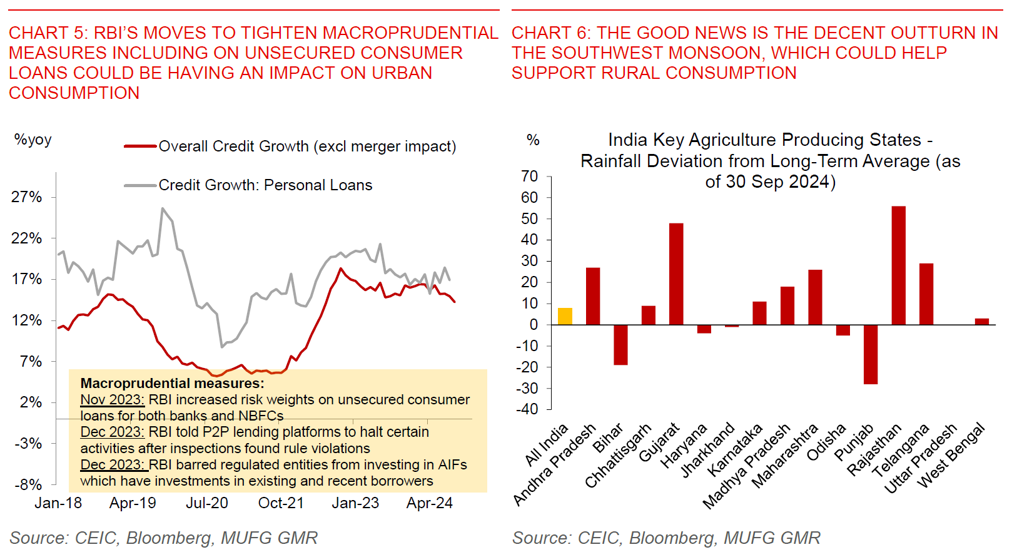
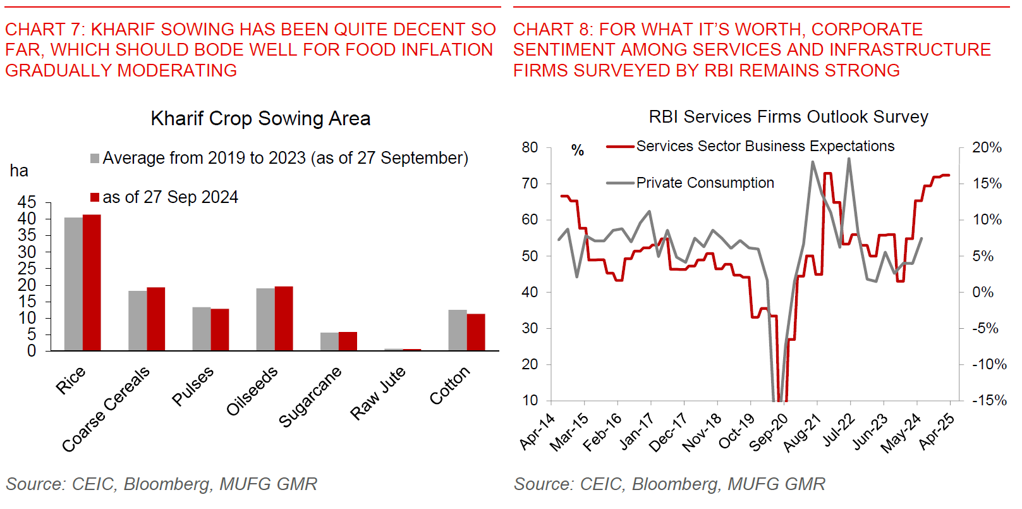
We expect the current account deficit to remain sticky at around 1.4% of GDP despite lower oil prices: This is in part because the recent gold import duty cuts have had a larger impact on gold imports than we anticipated, and is also driven by our forecasts for investment activity both public and private to remain strong moving forward notwithstanding the slowdown in urban consumption. As a base case, we assume some modest moderation in both gold and investment-related imports, and for the current account deficit to be capped by slower services imports growth due to the lagged impact of softer container freight rates and more manageable oil price pressures moving forward (notwithstanding left tail risks from geopolitics – see below).
Current account deficit should be easily financed by portfolio inflows including from bond index inclusion: We think that the strong portfolio inflows that India has been seeing should be able to continue, with still strong investor sentiment towards India’s long-term growth prospects. In addition, the bond inflows that we have seen from the JPM GBI-EM index inclusion should still continue over the next few months, even if the pace could slow given the rally that we’ve already seen in IGB bond yields. We have not assumed inflows from a possible addition of IGBs into the Bloomberg Barclays Global Agg index, and we may get an announcement later in 1Q25 (CY). The one key disappointment in terms of inflows have been in FDI, but over here, we expect some improvement as chunky divestment activity fades.
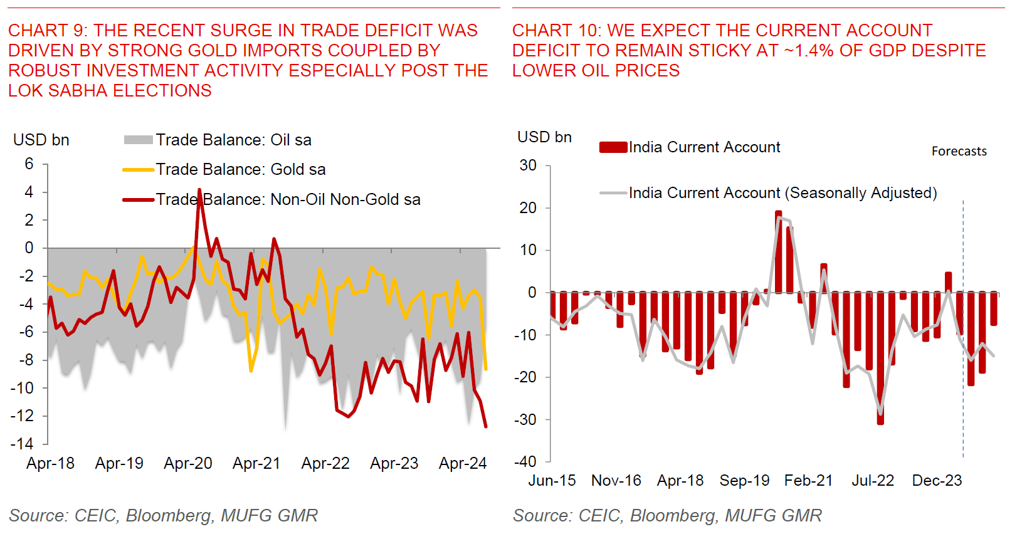
We forecast USD/INR to trade between 83.50 and 84.00, underperforming Asian currencies as the Dollar weakens, with a Harris Presidency + split Congress our base case assumption for the US elections. Geopolitical risks in the Middle East and possible spikes to oil prices are also key left tail risks: We continue to think that sharp INR weakness and spikes are unlikely, and expect RBI to remain an important player and cap any sharp moves in INR both ways (see India: Will INR weaken further?). The nuance is that we are effectively assuming a Harris Presidency in our base case, and the impact of a possible Trump Presidency on INR will also depend on the extent and timing of his proposed tariffs. As a general statement, we think INR should be less volatile than the likes of CNY and KRW – but certainly not completely immune – if Trump is to be elected as President and meaningful tariffs were to be imposed. There is also a risk that India may be singled out in US Treasury’s Currency Manipulation report given that it would likely fufill at least two out of three criteria. Meanwhile, we also have geopolitical risks in the Middle East to contend with. While our base case is for a modest move higher in oil prices to the US$80+/bbl handle, we note India is relatively more exposed in a left-tail risk scenario, both because of possible spikes to oil prices widening the trade deficit, and because India is relatively more exposed to GCC/Middle East end-demand compared with other Asian countries.

